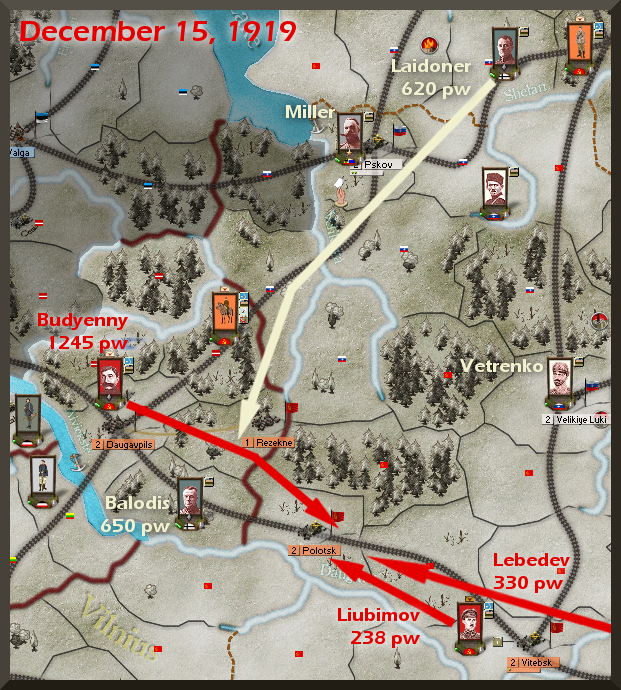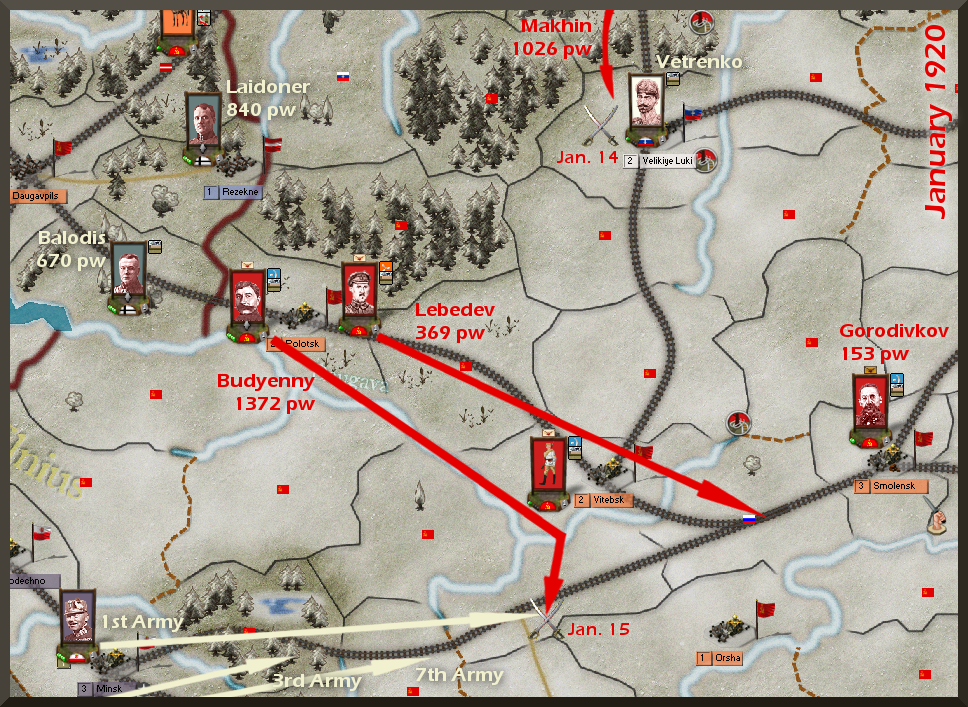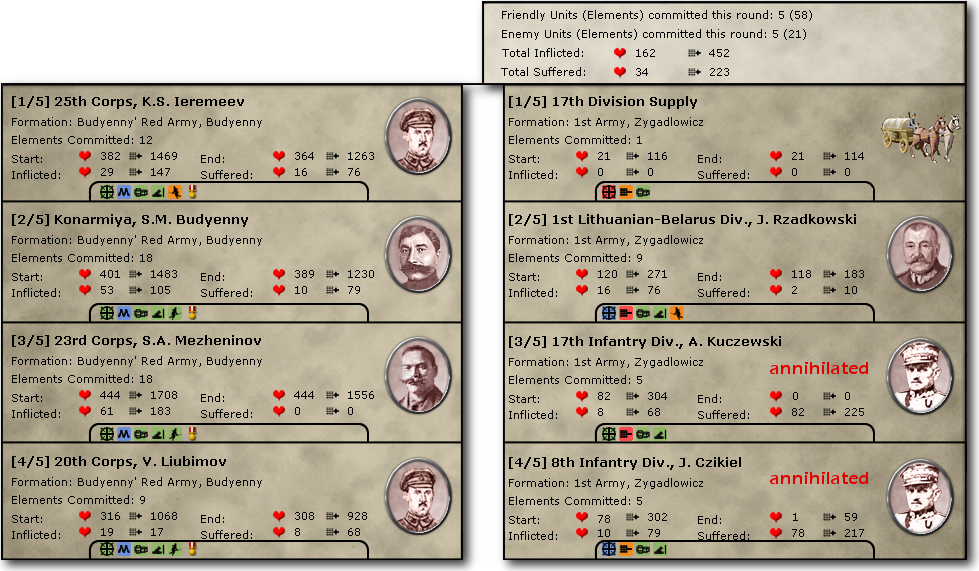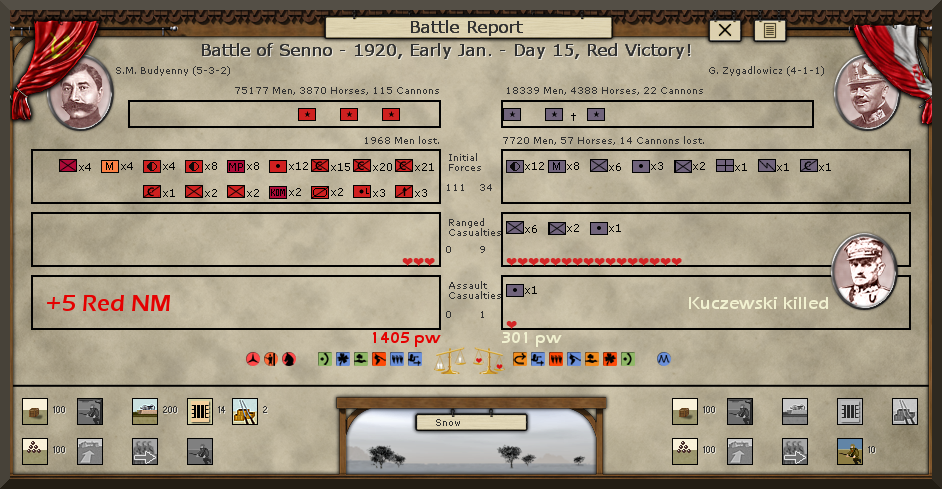Chapter 24 - Day of Anger: Kharkov, January 1920
When the speeches of Wilson, Clemenceau, and Lloyd George, the worst of the predators, the wild beasts of imperialism, are repeated here by Martov in the name of the Russian Social Democratic Labour Party … then I say to myself that we have to be on the alert and to realise that the Cheka is indispensable!
-
Lenin
Since the first two Battles of Merefa in September 1919, the front in the Ukraine had been relatively calm. The war had stagnated into trench warfare with neither side willing to risk an attack. The Red Army under Stalin's command was holding its positions around Kharkov. Currently the main frontline was stretching from Merefa in the South along the railway all the way north to Belograd. Weaker Red forces were guarding the railway line north to Kursk. The entire supply of these troops relied on a single railway line connecting Kharkov with Kursk. Its protection was thus the top priority. In order to keep the enemy in uncertainty, the Red corps were constantly shifted around. False weak points were created to bait the Volunteers and their foreign lackeys into attacks. But lately the Whites hadn't fallen for these traps. Rather, they had patiently increased their troop strength in the sector and waited for an opportunity.[1] By January 1920, White forces were slightly superior – if not in numbers than at least in fighting power. It was evident that new attacks were imminent.
The dreaded blow landed on January 11. The Whites had chosen their spot well: Denisov's powerful corps had outflanked Stalin and attacked Belograd in his rear. Initial contact was made with an Anarchist raiding party that had come east to resupply. Unfortunately, it ventured beyond Orzhonikidze's trenches.[2]
When the unlucky Anarchists made contact with Denisov's entire corps. They were hopelessly outnumbered. 5 cavalry regiments, supported by two light artillery batteries were facing three elite White divisions. Not bothered by these odds. The Anarchists made a valiant – if utterly stupid – charge. The carnage was horrific. Hardly an Anarchist survived the mad attack.
Ordzhonikidze, who could have helped, gave his men orders to stay in their trenches while he watched the slaughter in his binoculars. He wasn't unhappy if the White exhausted themselves butchering Anarchists. In the meantime, he sent out a telegram requesting help from Stalin and Berzin. The Anarchists' sacrifice bought the necessary time, when Denisov's men finally attacked the Red trenches, they found themselves outnumbered by 3:1. Now the three White divisions were engaged by five Red corps.[3]
The White veterans weren't bothered by these odds. They pressed the attack hard. Especially Drozdovsky's Division came dangerously close to breaking the Red lines. But Denisov was realist enough to realize that he couldn't break through 140.000 Reds with his 44.000 men. The attack was called off. Although a failure in the strategic sense, since Belograd was still in Communist hands, it had succeeded on a tactical level. The Red army had lost almost 9.200 men as opposed to 5.000 White casualties.
The success made the Whites more confident – overconfident some might say – a follow-up attack was ordered. The target was once again Merefa on the southern tip of the Red line. Berzin had created a opening, when he had relocated his army to the West of Kharkov. But this had been nothing but a feint. Immediately he headed back to Merefa by railway and was joined by two corps under Voroshilov on his way.
When Sidorin and Nither led their two corps into combat on the morning of January 23rd, they found four Red Army corps where they had expected nothing but a small Anarchist screening force.[4] Nither's corps was relatively small it contained Shkuro's elite “White Wolves” cavalry division as well as three Greek regiments – each of which was actually a small brigade. Sidorin's corps was another multinational force: two French and three Volunteer divisions were supported by an independent cavalry brigade.
Sidorin proved himself to be a true gentleman – during an opulent dinner on the eve of battle, the two French generals, Nerel and Borius, were offered the honour of charging first with their gallant French troops. Not wanting to lose face, the two Frenchmen had little choice but to accept and it was thus their soldiers that suffered most while Sidorin was enjoying the spectacle sipping champagne in his headquarters.
The attack began very well coordinated: Nither and Sidorin had synchronized their march to Merefa perfectly. However, the attack was less coordinated since Nither held off a charge while Sidorin ordered an assault immediately. Borius' 156th Infantry Division led the attack. However it got bogged down half way across the no-man’s land. The Frenchmen fell like flies under constant artillery bombardment. The 30th French Infantry Division and Subbotin's 15th Volunteer Division were sent in to get the attack going again but they didn't mange to advance much further. Frustrated by what he called “the mud-wrestling of infantrymen”, the commander of the 13th Cavalry Brigade had the glorius idea to charge through the middle. The result was a dreadful meat-grinder of dead mounts and screaming horsemen. It was a bad re-enactment of Agincourt with a bloody dash of Crécy.
After two hours of fighting, the situation deteriorated further as a fresh Red corps under Zhdanov arrived from Kharkov together with Stalin who took over command from Berzin. Nither had seen enough and gave his corps orders to retreat although it had yet to suffer any casualties. Sidorin was furious at this Greek treachery, but it was already too late for him to disengage with three of his five divisions pinned down in the noman's land. The attack had to continue. His men were ordered to assault the Red left flank where Zhdanov's corps had just taken up position. The Reds were punished harshly. Within the next two hours one in five out of Zhdanov's men would die. Nevertheless, they held the line. But the Red conscripts had little choice as Stalin had positioned a cheka regiment in their rear with orders to shoot anyone who fled.
Yet, Sidorin still didn't cancel the attack. By the fifth hour of fighting Pokrovsky's small corps had arrived on the battlefield and was immediately sent into combat. Hardly out in the open, Pokrovsky's men were torn into pieces. The 15th Terek Plastun Batallion was completely wiped out and the 12th Infantry Brigade fared little better. After 6 hours of bloody fighting, Sidorin finally ordered the retreat. 22.714 White soldiers had fallen, roughly one third of the entire force engaged in the battle. Red casualties were bad as well; 15.754 Communists had died. But Stalin's forces were still in decent fighting shape. Even Voroshilov's 10th Corps and Zhdanov's 26th Corps – the two Red Army formations who had suffered worst - still had 78% of their men ready for another battle.[5]
Further east a much smaller battle had occurred. Kravchenko had led a Red cavalry corps to hunt down some White partisans just west of Tzaritsyn. The mission was a full success. The White horsemen were ambushed and slaughtered. The Red Army suffered only one victim: the commanding officer himself. Rumour has it he fell from his horse drunk and broke his neck.[6]
The last Anarchists weren't keeping quiet, either. Since the area around Kharkov had become too invested with White troops they had evaded to the North of Kiev and lauched a serious of raids across the Donets.
On January 27, they attacked the city of Bila Tsverka, just south of Kiev, and wiped out a Greek double-regiment.[7]
------------------------------------------------------
[1] Obviously my position was highly advantageous – my corps could mutually support each other while Ian's forces were stretched out in a crescent and no longer able to provide mutual assistance. Under those circumstances, my only worry was an attack deep into my rear, for that reason I dispatched Kirov's corps to extend the line even further back.
[2] The Anarchists had march and combine orders, but hadn't yet joined Ordzhonikidze's stack when the Volunteers attacked. Even worse, it had gone through Ukrainian territory on its way and consequently switched to offensive posture. Thus only the Anarchists engaged in the first round of battle, while Orzhonikidze's army set back on defensive posture.
[3] White divisions were of the same size as Red corps. Weirdly, Ordzhonikidze's men still didn't engage. The fighting was exclusively done by Stalin's and Berzin's stacks. Thus the Whites were probably only outnumbered by 2:1 in the second battle round. Nevertheless, it is rather surprising that they inflicted slightly more casualties than they suffered.
[4] I had used this single regiment to keep the railroad intact and preserve the trenches. Berzin had move and combine orders and thus reoccupied these trenches.
[5] In spite of these high casualties, very few elements were destroyed. The reason for this is that both Ian and myself used big formations for the most part. The eliminated elements had all been part of units not incoorporated into divisions. Once again, this proves how important it is to create big divisions!
[6] And another one bites the dust … I hate these battles where the only casualty is my general.
[7] Killing French and Greek troops is an easy way to gain NM since they are high-value targets.

 o
o That is quite an honour. I am a very happy AAR writer right now.
That is quite an honour. I am a very happy AAR writer right now.




















